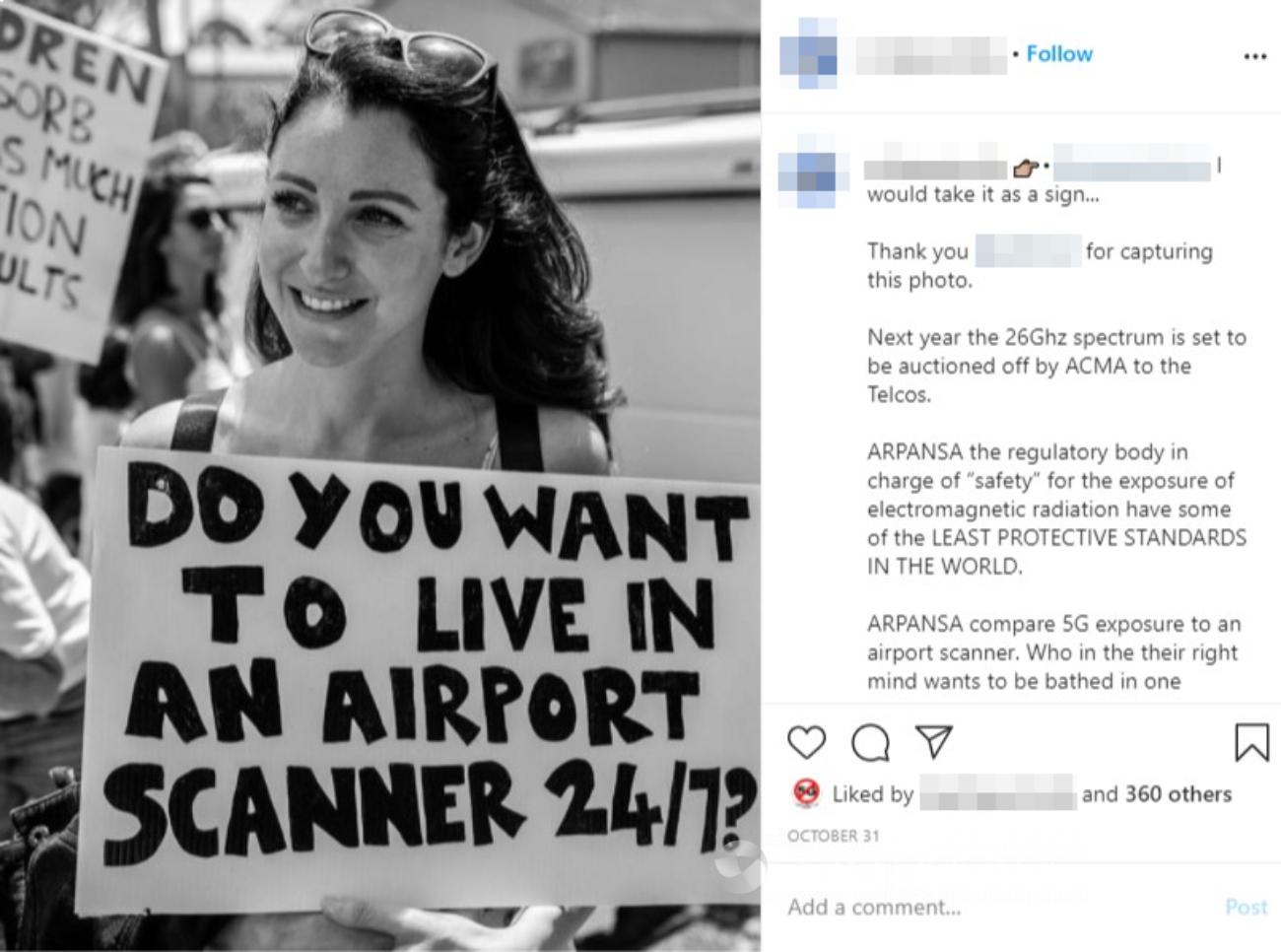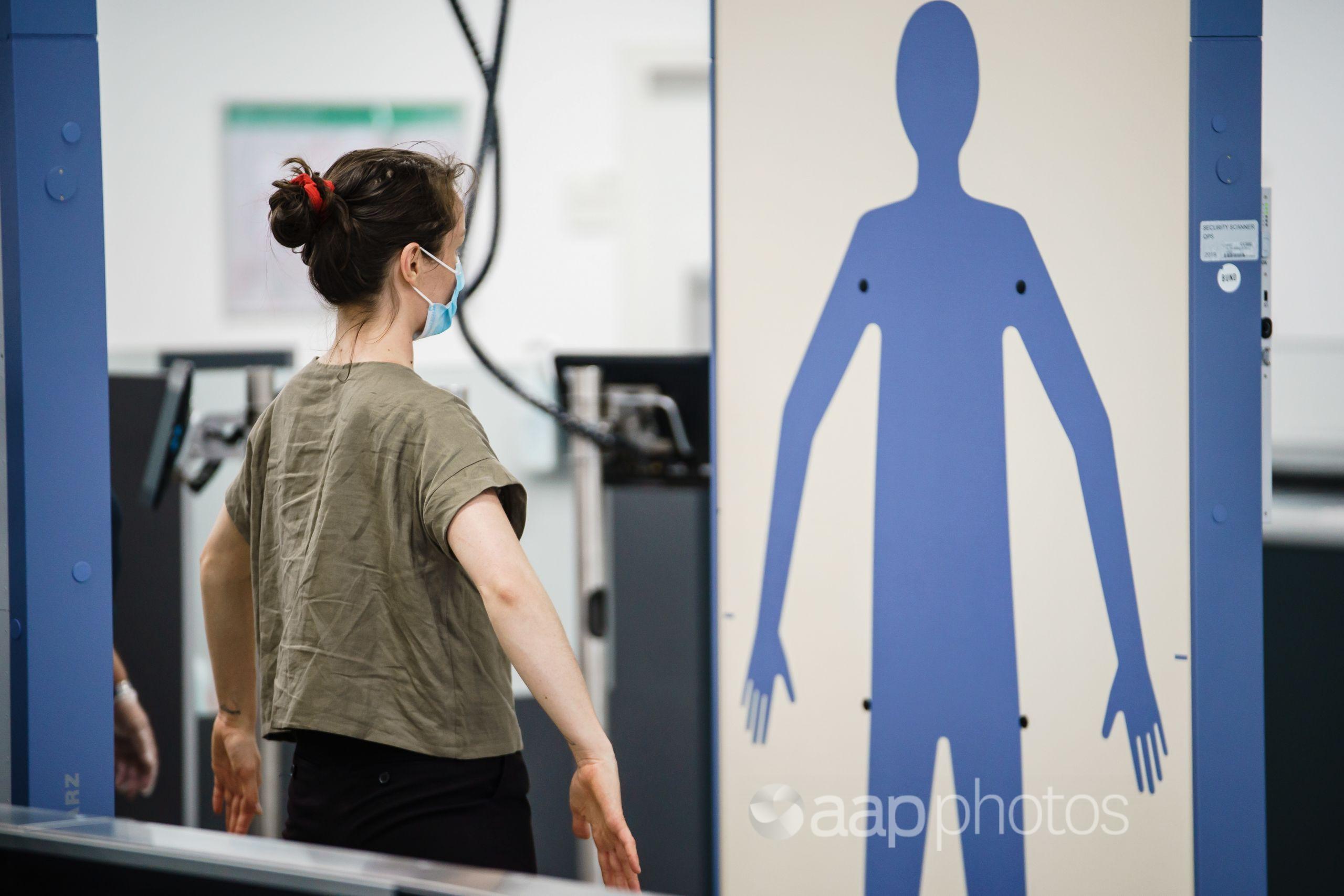The Statement
An Instagram post claims Australia has some of the least protective standards for electromagnetic radiation in the world, and compares the radiation from 5G mobile networks to living in an airport security scanner.
The post includes a photo of a woman holding a sign which says, “Do you want to live in an airport scanner 24/7?”
The text adds that the 26GHz radio spectrum is going to be auctioned off to 5G network providers next year before it goes on to claim that Australia’s radiation standards are lax.
“ARPANSA the regulatory body in charge of ‘safety’ for the exposure of electromagnetic radiation have some of the LEAST PROTECTIVE STANDARDS IN THE WORLD,” the post says.
“ARPANSA compare 5G exposure to an airport scanner. Who in the their right mind wants to be bathed in one 24/7?!”
At the time of publication the October 31 post, from an anti-5G Instagram account, had more than 350 reactions and had been viewed at least 6700 times.

The Analysis
The latest iteration of mobile technology, so-called fifth-generation or 5G, is in the process of being rolled out across Australia.
The technology has been live since 2018, with Telstra, Optus and Vodafone all building transmission sites in the major cities. Telstra says its network already reaches more than 41 per cent of the population, to rise to 75 per cent by mid-2021.
Current networks operate in the 3.4-3.7 gigahertz (GHz) frequency band, slightly above the spectrum used by 4G. However, the Australian Communications and Media Authority says it plans to auction licences for the 26 GHz spectrum for 5G in April 2021.
In an attempt to explain that using these higher frequencies is safe and not new, Australian Radiation Protection and Nuclear Safety Agency (ARPANSA) assistant director of assessment and advice Ken Karipidis has compared 5G to airport scanners in multiple press releases (here and here).
“In our community today, there are a range of devices and applications that utilise higher frequencies, for example security screening units at airports, police radar guns to check speed, remote sensors and in medicine,” Dr Karipidis said in one example.
So is the radiation from 5G like living inside an airport scanner, as the post claims?
There are two main types of airport security scanners commonly in use. One is the backscatter X-ray scanner, which relies on low-dose X-rays similar to those used in medical imaging, according to an article in the Archive of Internal Medicine.
These scanners emit low doses of ionising radiation, which had been linked to cell damage and cancer in higher doses, the article said. These scanners are no longer used in the US, Europe, Australia or New Zealand.
The other type of scanner uses millimetre waves operating within a similar spectrum to that proposed for 5G. These scanners emit non-ionising radiation, which hadn’t been linked to cell damage or cancer, at a “small fraction of the energy of a cell phone”, the article said.
The Australian government says radiation from the machines was “thousands of times lower than that of a single phone call and comparable to passive exposure to a mobile phone used several metres away”, while US authorities provide similar guidance.
A 2017 consensus report from the US-based National Academies of Sciences, Engineering and Medicine found the maximum radiation exposure during testing of several airport millimetre wave scanners was 0.00003 watts per square meter (W/m2) at a distance of 60cm, where a person usually stood during a scan. It said this was 320,000 times lower than the US government’s guideline of 10 W/m2.
This level is a fraction of the measured radiation from 5G transmitters. A report by UK communications regulator Ofcom measured radiation at 22 sites around Britain, including at 5G base stations, and found the highest detected level of radiation was 1.5 per cent of the International Commission on Non-Ionizing Radiation (ICNIRP) guidelines of 10 W/m2. The tested networks operated on frequencies up to 4.2 GHz.
The NZ Ministry of Health says measurements at laboratory and operational 5G sites in Australia had shown that radiation from 5G signals was similar to, or lower than, those from existing cell phone sites, and a small fraction of the exposure standards (page 2).
ICNIRP also says “initial measurement studies suggest that exposure from 5G antennas will be approximately similar to that from 3G and 4G antennas”.
ICNIRP chair Rodney Croft, who is a professor of health psychology at the University of Wollongong, told AAP FactCheck via email there were similarities between millimetre wave airport scanners and 5G as both emitted low levels of radiation which did not penetrate deeply into the body.
“The scanners are well-within the ICNIRP restriction levels, and recent research shows that 5G exposure levels are within the range of 100 to 1000 times lower than the restriction levels,” Dr Croft said.
“Importantly, in both cases they must operate within the ARPANSA restrictions, and so neither will cause any harm.”
Dr Karipidis told AAP FactCheck during a phone interview that it was difficult to accurately compare the level of radiation from 5G and an airport security scanner as it depended on the proximity to the source of radiation.
“But the general point is all of these exposures are much lower than the Australian or the international guidelines,” he said.
“The radiation from a millimetre scanner is also non-ionising which means it doesn’t accumulate. So as long as it is below the safety standard you, could stand in an airport scanner 24/7 and have no health affect.”
The other claim in the post is that ARPANSA’s electromagnetic radiation standards are among the least protective in the world.
ARPANSA says its exposure limits are “aligned with international guidelines prepared by ICNIRP and endorsed by the World Health Organization (WHO)”.
GSMA, an industry association representing global mobile operators, says 152 countries use the ICNIRP limits.
A 2018 report by the Netherlands National Institute for Public Health and the Environment compared international policies on electromagnetic radiation. It found Australia’s policies on the exposure of radiofrequency fields for the general public were identical to EU recommendations (page 11).
A table comparing exposure limits between selected countries showed China, India, Russia and several European countries had stricter radiation limits than Australia for transmission at certain frequencies (table 1, page 15).
A literature survey which looked at regulations and health effects of millimetre-wave frequencies said exposure limits in Russia, China, Switzerland and Italy were two orders of magnitude lower than the ICNIRP standards used by Australia.
It also said the United States Federal Communications Commission (FCC) standards were stricter than the ICNIRP standards at some frequencies (see figure 1).
ARPANSA says some countries have lower permitted radiation levels than Australia but “these limits are not based on substantiated scientific evidence”.
Dr Croft said the ICNIRP standards used by ARPANSA were best practice and the most widely used in the world.
“There are some countries that have lower restrictions, but these are not science-based,” he said.
“For instance, India simply reduced the ICNIRP restriction values by an arbitrary factor of 10 and used those lower values as their restrictions. However, although lower, India’s restrictions do not provide additional benefit to health.”
Nevertheless, Mary Redmayne, a Monash University adjunct research fellow with expertise in radio frequency radiation and its health effects, said the ICNIRP standards could be considered among the least protective in the world because few countries had lower standards and a number of countries used stricter provisions.
“More than half the world’s population is under more stringent standards than Australia’s,” she told AAP FactCheck.
The Verdict
AAP FactCheck found the post’s claim that radiation from 5G is equivalent to being continuously exposed to an airport security scanner and Australia’s electromagnetic radiation standards are among the least protective in the world to be missing context.
Australia adheres to international radiation guidelines used in numerous countries, including most in the European Union, however a number of countries have stricter standards.
While it is difficult to compare the level of radiation between a millimetre wave airport security scanners and 5G, both use similar frequency ranges and emit non-ionising radiation at levels well below international limits.
Missing Context – Content that may mislead without additional context.
* AAP FactCheck is an accredited member of the International Fact-Checking Network. If you would like to support our independent, fact-based journalism, you can make a contribution to AAP here.
All information, text and images included on the AAP Websites is for personal use only and may not be re-written, copied, re-sold or re-distributed, framed, linked, shared onto social media or otherwise used whether for compensation of any kind or not, unless you have the prior written permission of AAP. For more information, please refer to our standard terms and conditions.


















